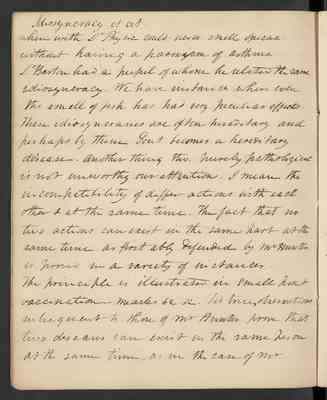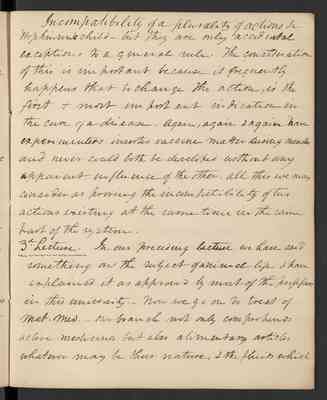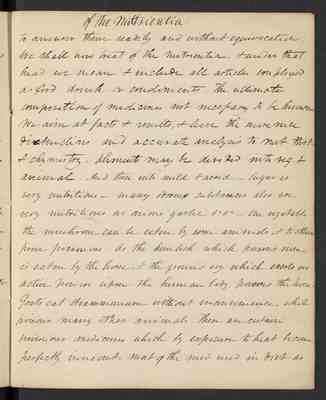Pages
11
Sympathy et cet
We have instances of certain persons who cannot eat certain substances without suffering from eruptive diseases. Some cannot eat fish without exposing themselves to an unpleasant eruptive disease. I do not assert that sympathy offers a complete explanation of the modus operandi of medicines but that it assists as much cannot be denied. And do we better explain the mod operandi of medicines mercury when we say it is taken into the circulation and there stimulates the heart and arteries? Another thing which we should keep in view is that peculiarity in individuals & families, termed idiosyncracy as it is a thing we frequently meet with in practice. Some cannot receive the odour of certain substances without the greatest inconvenience whilst the same odour produces little or no comparative effect upon the organ of smell in the generality of men. Dr. Brown who was a fellow pupil with me
12
Idiosyncracy et cet
when with Dr. Physic could never smell ipecac without having a paroxysm of asthma. Dr. Barton had a pupil of whom he related the same idiosyncracy. We have instances where even the smell of fish has had very peculiar effects. These idiosyncrasies are often hereditary and perhaps by these Gout becomes a hereditary disease. Another thing tho. purely pathological is not unworthy our attention. I mean the incompatibility of different actions with each other & at the same time. The fact that no two actions can exist in the same part at the same time as first ably defended by Mr. Hunter, is proven in a variety of instances. The principle is illustrated in small pox & vaccination—measles c c. Tis true, observations subsequent to those of Mr. Hunter prove that two diseases can exist in the same person at the same time, as in the case of Mr.
13
Incompatibility of a plurality of actions c.
Hopkinson's child—but they are only accidental exceptions, to a general rule. The consideration of this is important because it frequently happens that to change the action, is the first & most important indication in the cure of a disease. Again, again, & again have experimenters inserted vaccine matter during measles and never could both be developed without any apparent influence of the other. All this we may consider as proving the incompatibility of two actions existing at the same time in the same part of the system.
3d Lecture In our preceding lecture we have said something on the subject of animal life. I have explained it as approved by most of the professors in the university—Now we go on to treat of Mat. Med.—our branch not only comrephends active medicines but also alimentary articles whatever may be their nature, & the fluids which
14
Materia Medica
we use as drinks. In former times much was said of diet by the physicians, but now it seems to be consigned to the management of friends & nurses. In many diseases proper aliment is all that is necessary to effect a cure. One thing I must suggest to you & you will consider it of some importance to remember it; that the diseases of the United States require a more rigid diet than those of any other country. In vain we do any thing and every thing without without [sic] attention to this imporant part of the treatment of our diseases, namely a rigid attention to diet. You will therefore see the necessity of attending to the articles of diet in the neighborhood where you live, & you may rest assured that the dietetick part of your practical duties will form an important object in claiming your attention. You will always be asked Dr. Shall I eat apples, pears, peaches, oysters c c. You must be able
15
of the Nutrientia
to answer them readily and without equivocation. We shall now treat of the nutrientia, & under that head we mean & include all articles employed as food, drink or condiments. The ultimate composition of medicines not necessary to be known. We aim at facts & results & leave the more nice distinctions and accurate analysis to nat. hist. & chymistry. Aliments may be divided into veg. & animal. And these into mild and acrid—Sugar is very nutritious—many odorous substances also are very nutritious as onions garlic c c—One vegetable the mushroom can be eaten by some animals, and to others prove poisonous. As the hemlock which poisons men, is eaten by the horse, and the ground ivy which exerts no active powers upon the human body, poisons the horse. Goats eat strammonium without inconvenience while poisons many other animals. There are certain poisonous medicines which by exposure to heat become perfectly innocent. Most of the med. used in diet as







